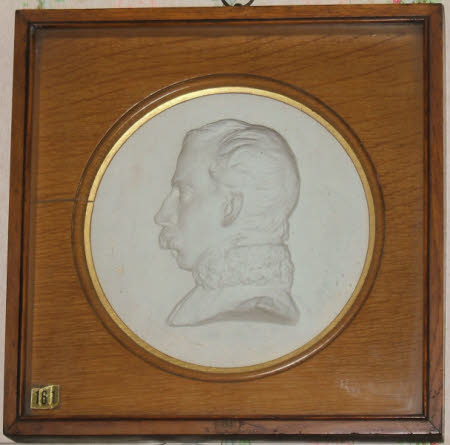Elénore-Louis-Godefroy Cavaignac
Pierre-Jean David d'Angers (1788 - 1856)
Category
Art / Sculpture
Date
1834
Materials
Plaster
Place of origin
France
Order this imageCollection
Carlyle's House, London
NT 263808
Summary
Plaster portrait medallion of Elénore-Louis-Godefroy Cavaignac (1801-1845) by Pierre-Jean David d’Angers’ (1788-1856). The moustachioed sitter faces left, dressed in coat with fur collar. Inscribed at right ‘G. Cavaignac’ and signed below truncation of the bust ‘David 1834’, the date largely effaced. Handwritten label on reverse: ‘Bought at the sale of the late Alexr. Carlyle/June 1932. From the Dressing Room of his Uncle Thos. Carlyle. Given to Basil Williams by D.G.’ Presented by Professor Basil Williams.
Full description
David d’Angers was a French sculptor who is best known for the large number of portrait medallions he made of his contemporaries in France and other European countries which, collectively, form a veritable historical gallery of the age in which he lived. The portrait of the Carlyles’ friend Cavaignac is an excellent example of his skills as a portraitist. Elénore-Louis-Godefroy Cavaignac (1801-1845) was a French politician. The son of a member of the Convention, he was brought up in a republican tradition, playing an important role in the July Revolution of 1830 in France, that saw the overthrow of King Charles X and his replacement by his cousin Louis Philippe, Duke of Orleans. Cavaignac was disappointed by this outcome and quickly returned to revolutionary activities. In 1834 he was imprisoned, but in 1835 he escaped to England. Returning to Paris in 1841, Cavaignac continued to write republican propaganda and founded the Society for the Rights of Man, of which he became president in 1843. In 1834, the year of his imprisonment and the date of David d’Angers’ medal, Cavaignac published an article on the cultural achievements of the French Revolution (‘Monuments révolutionnaires’, Revue républicaine, III (1834), pp. 155-59. This or the circumstance of Cavaignac’s imprisonment might have prompted the creation of David d’Angers’ portrait, one of hundreds of distinctive medallion portraits of his contemporaries made by the sculptor. Thomas and Jane Carlyle came to know Cavaignac in 1836 during the Frenchman’s exile in Britain between 1835-41 and they became good friends (for their relationship, see Frederick W. Hilles, ‘The Hero as Revolutionary: Godefroy Cavaignac’ in John Clubbe, ed., Carlyle and his Contemporaries. Essays in honor of Charles Richard Sanders, Durham NC 1976, pp. 74-90). The passionate Byronic young revolutionary made an especial impact on Jane Carlyle, who wrote of his ‘sort of dark, half-savage beauty with which one would paint a fallen angel… who fears neither Heaven nor Earth.’ Carlyle himself thought Cavaignac ‘a courageous energetic man… The best Frenchman by many degrees whom I have met with’, but one burdened by his radical inheritance: ‘Poor Cavaignac! there is a kind of gloomy Satanic strength in him; but he is possessed with “revolution”; the curse of Ezekiel has fallen upon him: he is “made like unto a wheel”’ (Letter of 20 January 1834 to John Stuart Mill. Charles Richard Sanders and Kenneth J. Fielding, eds., The Collected Letters of Thomas and Jane Welsh Carlyle, Vol. 7 (October 1833-December 1834), Duke University Press, Durham NC 1977, p. 73). Carlyle found his long conversations with the Frenchman of great assistance in helping him to develop his own ideas about the French Revolution. It is conceivable that this portrait was a gift and token of friendship from the sitter to the famous historian of the French Revolution. The portrait was acquired in 1836, at a time when the Carlyles and the Cavaignacs saw one another frequently. It is likely to be the portrait referred to in a letter of 11 September 1836 to Susan Hunter, in which Carlyle described a number of new acquisitions in his and his wife’s house: ‘We have another foreigner that beats all the rest to sticks. A French republican of the right thro’going sort, an ‘ACCUSE D’AVRIL’ who has had the glory of meriting to be imprisoned, and nearly losing his head, a man with that sort of dark half-savage beauty with which one would paint a fallen angel, who fears neither Heaven nor Earth for aught one can see, who fights and writes with the same passionate intrepidity; who is ready to dare or to suffer, to live or to die without disturbing himself much about the matter, who defies all men and honours all women – and whose name is Cavaignac!’ (Charles Richard Sanders and Kenneth J. Fielding, eds., The Collected Letters of Thomas and Jane Welsh Carlyle, Vol. 9 (July 1836-December 1837), Duke University Press, Durham NC 1981, pp. 56-57). The medallion is said to have been acquired at the sale of most of the contents of Carlyle’s House in 1932, but does not appear in the printed auction catalogue. It is noted as being offered as a gift to the National Trust in 1937 (Minutes of the Meeting of the Advisory Committee, Friday October 15th 1937): 'Gifts to the Trust. The Secretary reported that the Trust had been offered the following gifts. A bas-relief of General Cavaignac which formerly hung in Carlyle's dressing room.' Jeremy Warren December 2017
Provenance
Acquired by Thomas Carlyle (1795-1881) in 1836. Alexander Carlyle (1843-1931). Sotheby’s London, 13-14 June 1932. Bought by D.G. Professor Basil Williams (1867-1950), by whom given to the National Trust in 1937.
Credit line
National Trust Collections (Carlyle's House, Chelsea)
Marks and inscriptions
Front right: ‘G. Cavaignac’ Handwritten label on reverse: ‘Bought at the sale of the late Alexr. Carlyle/June 1932. From the Dressing Room of his Uncle Thos. Carlyle. Given to Basil Williams by D.G.’ Front, below truncation: ‘David 1834’, the date largely effaced. Reverse: Handwritten label on reverse: ‘Bought at the sale of the late Alexr. Carlyle/June 1932. From the Dressing Room of his Uncle Thos. Carlyle. Given to Basil Williams by D.G.’
Makers and roles
Pierre-Jean David d'Angers (1788 - 1856), sculptor
